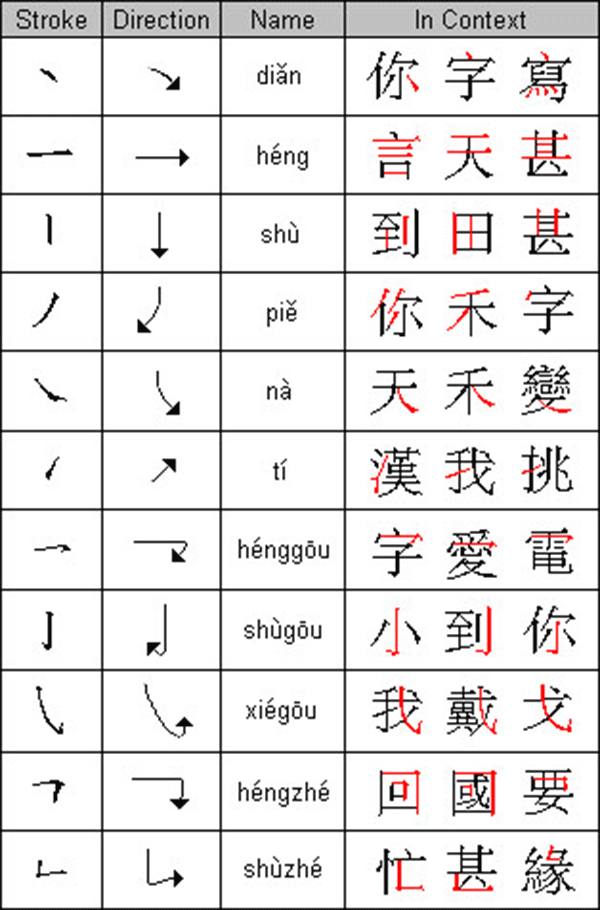Why Chinese stroke order is important and how to master it?

When it comes to writing Chinese, stroke order is surprisingly important. The Chinese take great pride in their language, which includes the complex writing system.
First, let’s talk a little bit about strokes themselves. As you can see from the graph below, there are 11 basic strokes that comprise all Chinese characters.

Using the wrong stroke order or direction would cause the ink to fall differently on the page. You can see that the “捺 (nà)” stroke has starts out thin, but thickens and thins out again in an elegant sweep. Should you write it backwards, you would not have the same effect. Don’t believe me? Try writing the letter “S” on a piece of paper. Now try recreating it, but start from the bottom instead. Do you see how you lose some of that natural flow?
The Chinese have always believed in balance and harmony. For example, when one fell ill, he or she was thought to have an imbalance of yin and yang in his or her body system. Traditional Chinese medicine was produced to restore balance.
Similarly, the Chinese stroke order system was designed to produce the most aesthetical, symmetrical, and balanced characters on a piece of paper. Furthermore, it was also designed to be efficient – creating the most strokes with the least amount of hand movement across the page. You may notice that all Chinese characters fit neatly into a square box. None of them skew dramatically to one direction or the other, which again reflects how much we value symmetry and balance.
“永(yǒng)” the character for eternity, is often the poster-child character for calligraphers. If you examine this character closely, you will notice that this one character has 8 of the most common stroke types that appear in the Chinese writing system. This is why calligraphers are often judged on skill by how well they write the character 永.

When children are learning to write at a young age, Chinese stroke order is often taught to them using the “Eight Principles of Yong,” which are the 8 different strokes combined in this one character. Frequent practice of this character can improve basic handwriting.
Even in today’s technological age, knowing the proper stroke order can go a long way to helping you master Chinese. A lot of Chinese input methods and dictionary apps have a handwriting feature that requires the proper stroke order to recognize the character. Knowing Chinese stroke order will also help you understand “草书 (cǎo shū)” or “Chinese cursive writing.” My knowledge of stroke order has helped me decipher messy Chinese handwriting on more than one occasion.
Here are some tips on mastering stroke order.
1. Top to bottom
When a Chinese character is “stacked” vertically, like the character 立 (lì) or “to stand,” the rule is to write from top to bottom.

2. Left to right
When a Chinese character has a radical, the character is written left to right. The same rule applies to characters that are stacked horizontally. Take a look at the “吃 (chī)” example below, which means “to eat.”

3. Symmetry counts
When you are writing a character that is centered and more or less symmetrical (but not stacked from top to bottom) the general rule is to write the center stroke first. Check out the character “小(xiǎo)” which means “small.”

4. Horizontal first, vertical second
Horizontal strokes are always written before vertical strokes. Check out how to write the character “十(shí)” or “ten.”

5. Enclosures before content
You want to create the frame of the character before you fill it in. Check out how to write the character 日(rì) or “sun.”

6. Close frames last
My mom used to teach me this concept by saying “you want to fill the closet before you close the door.” After you write the middle strokes, close the frame, such as in the character “回(huí)” or “to return.”

7. Character spanning strokes last
For strokes that cut across many other strokes, they are often written last. For example, the character 半 (bàn), which means “half.” The vertical line is written last.

There are always small exceptions to the rule, and Chinese stroke order can vary slightly from region to region. However, these variations are very miniscule; so by following these general tips, you’ll have an astute grasp on stroke order!
Personal handwriting is also important in Chinese culture. In Chinese, we have a saying called “字如其人(zì rú qí rén),” which means “the handwriting reflects the person.” According to my harshest handwriting critic, (my mother) my handwriting says that I am “disorganized, daring, and a little out of the box.” Clearly, I need more practice. What do you think your Chinese handwriting says about you? Hopefully with these tips, you’ll be on your way to improving your handwriting!
MOST POPULAR
- 1 Things to know about China Intl Consumer Products Expo 2024
- 2 China tops FDI confidence index of emerging markets
- 3 China specifies steps to improve payment services in tourist attractions
- 4 Low-altitude economy set to take off
- 5 China's immigration service platform receives over 10m calls from home, abroad
Editors' Picks
 Infographic:
A look at China's economy in Q1 of 2024
Infographic:
A look at China's economy in Q1 of 2024
 Infographic:
China to remove foreign ownership restrictions in value-added telecom services in pilot areas
Infographic:
China to remove foreign ownership restrictions in value-added telecom services in pilot areas
 Infographic:
2023 Sino-German investment and trade in numbers
Infographic:
2023 Sino-German investment and trade in numbers
 Infographic:
China-Germany relations in graphic
Infographic:
China-Germany relations in graphic



